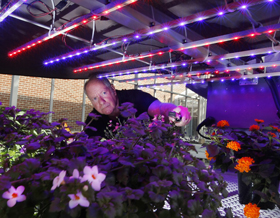- News
12 November 2010
USDA awards $4.88m grant to study LED lighting of crops
 At the end of October, US Department of Agriculture (USDA) officials, including Deputy Secretary Kathleen Merrigan, toured Purdue University greenhouses equipped with with prototype LED lights in order to preview work that will come from its new $4.88m grant for the four-year project ‘Developing LED Lighting Technology and Practices for Sustainable Specialty-Crop Production’, which aims to increase greenhouse yields and decrease producers' energy costs.
At the end of October, US Department of Agriculture (USDA) officials, including Deputy Secretary Kathleen Merrigan, toured Purdue University greenhouses equipped with with prototype LED lights in order to preview work that will come from its new $4.88m grant for the four-year project ‘Developing LED Lighting Technology and Practices for Sustainable Specialty-Crop Production’, which aims to increase greenhouse yields and decrease producers' energy costs.
Picture: A USDA grant will help Cary Mitchell study LED lighting use in greenhouses. (Purdue Agricultural Communication photo/Tom Campbell).
The USDA Specialty Crops Research Initiative Award will include $2.44m from the USDA and an equal amount of in-kind contributions of equipment and services from industry partners. Researchers at Purdue will collaborate with Rutgers University, the University of Arizona, Michigan State University and Orbital Technologies Corp of Madison, WI, USA.
Fiscal |
Q4/2009 |
Q1/2010 |
Q2/2010 |
Q3/2010 |
Revenue |
$17.8m |
$18.6m |
$23.2m |
$26.8m |
“The high-intensity discharge lamps used today are inefficient. When you have acres and acres of greenhouses with these lamps in them, it really adds up,” said project director Cary Mitchell, a professor of horticulture at Purdue. “With LED lighting, we should be able to do as well or better with much less energy,” he adds.
“The specialty crop industry plays an enormously important part in American agriculture and is valued at approximately $50bn every year,” Merrigan said. “These projects will be key to providing specialty crop producers with the information and tools they need to successfully grow, process, and market safe and high-quality products.”
Mitchell’s work will include testing LED lighting on high-wire tomatoes, which can grow taller than 20 feet so that traditional overhead lighting doesn’t reach the lower parts of many plants. Mitchell believes that using LED lights on the sides of plants will increase photosynthesis and flowering, improving yield.
Assistant professor of horticulture Roberto Lopez will work with about 20 species of bedding plants to test the ability of LED lighting to lower the cost of establishing new plants from cuttings and seeds. Low winter light means growers currently have to use more expensive overhead lighting to establish new plants. John Burr, a lecturer in Purdue’s Krannert School of Management, will evaluate the costs and benefits associated with LED lighting.
A.J Both at Rutgers will be responsible for developing best practices and standards for testing commercial LED lighting. Chieri Kubota at the University of Arizona will test the optimal wavelengths and colors for LED lighting to establish vegetable transplants. Erik Runkle at Michigan State will test flower initiation of ornamental crops with different colors of LEDs, as well as performing project outreach.
The researchers are partnering with Robert Morrow and C. Michael Bourget of Orbital Technologies, which will build the LED lights.
Later phases of the research will include evaluating LED lighting in commercial settings and developing improved LED lights that match the needs determined from those tests.
SDK’s 660nm red LED chips adopted at Japan’s plant growth facility
UV LEDs yield deeper-color antioxidant-rich plants
